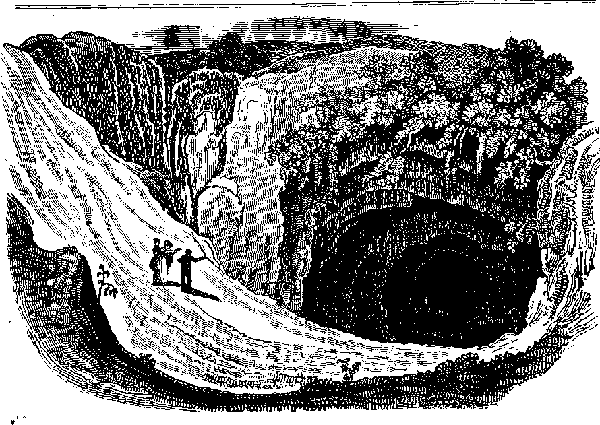Cave of Dunmore (Kilkenny)
[From the Dublin Penny Journal, Vol. 1, No. 10, September 1, 1832]

To the great and peculiar extent of calcarious or limestone strata of which our island is composed, we may chiefly attribute the fertility of our soil, and the salubrity of our climate; and if we dared venture to fathom the intentions of an Almighty and beneficent providence, we would point to this geological peculiarity, as a signal instance of his wisdom and goodness, as, exposed as we are to the exhalations of the Atlantic, and the influence of westerly winds, our soil would otherwise be unproductive and our climate unhealthy. To the same cause is to be attributed much of the peculiarly romantic beauty of which we may justly boast; our waterfalls without number, our subterranean rivers, our natural bridges, our perpendicular sea cliffs, and above all, our fairy caverns; all these are in almost every instance, the result of this extensive calcarious formation, and are consequently found in no other country of the same extent, in equal variety, beauty, and abundance. Most strange it is, that a land so blessed and ornamented by the hand of providence, should be so little appreciated and too often abandoned by those to whom its fertility gives wealth, and to whom its beauty should give delight and happiness.
We have alluded to the great number of calcarious caverns found in Ireland-they are to be met with in all the provinces, and rival each other in romantic beauty, but that best known for its size and extent is the one of which we present our readers with a sketch in the present number-the Cave of Dunmore. This famous cavern, which is situated near the edge of the calcarious district, in the county of Kilkenny, on the estate of the Marquess of Ormond, and about three miles from the beautiful inland capital of Ireland, is thus accurately described by the able pen of Mr. Banim-a writer of whom not only Kilkenny, but all Ireland may justly feel proud. It leaves us nothing to add.
"The absolute physiognomy of the place is calculated to excite superstitious notions. In the midst of a level field, a precipitate inclined plane leads down to a sudden pit, across which, like a vast blind arch, the entrance yawns, about eighty (fifty) feet perpendicular, and from thirty to forty wide, overhung and festooned with ivy, lichen, bramble, and a variety of wild shrubs, and tenanted by the owl, the daw, and the carrion crow, that made rustling and screaming exit into the daylight as soon as disturbed by an exploring foot; and when all at once, you stand on the verge of the descent, and look from the cheering day into the pitch darkness of this gaping orifice, repelling and chilling the curiosity that it excited,-giving a promise of something to be discovered, and a threat to the discoverer,- suggesting a region to be traversed so different from our own fair familiar world, and yet a nameless danger to be incurred in the progress,- your heart must be either very callous or very bold, and imagination entirely a blank, if, at the first glance, you feel no usual stir within you.
"After you enter the mouth of the cavern, the light of your torches show you that vast masses of rock protrude, overhead, ready at every step to crush, and held in their place as if by miracle alone. A short distance on, two separate passages branch to the right and to the left. To explore the one, a barrier of steep rocks, made dangerous by the damp slime that covers them, should be scaled; then you proceed along a way of considerable length, sometimes obliged from the lowness of the heading, to stoop on hands and knees, still over slippery rocks, and over deep holes, formed by the constant dripping of the roof; till at last you suddenly enter a spacious and lofty apartment, known by the name of the market-cross, from its containing a petrified mass that has some likeness to the ancient and curious structure, so called. Indeed, throughout the whole chamber, the awful frolic of nature bears comparison with art:-ranges of fluted columns, that seem the production of the chisel, only much dilapidated by time, rise almost at correct distances to the arching roof; by the way, having necessarily been formed by petrifaction, drop upon drop, it is astounding to think of the incalculable number of years consumed in the process. And this is the regal fairy hall; and the peasants say, that when the myriad crystalizations that hang about, are, on a gala evening, illuminated, and when the for-ever falling; drops sparkle in the fairy light, the scene becomes too dazzling for mortal vision.
"The other passage winds an equal distance, and leads to the subterranean rill that bubbles, as before mentioned, over scraps of human bones; and over some entire ones, too; we having, when led to the cavern for scenic illustration of the facts of this history, adventurously plunged our hand into the clear water, and taken therefrom a tibia of unusual length; and, indeed, the fact that such human relics are there to be seen, almost a quarter of a mile from the light of the earth, must, if we reject the peasant's fine superstition, show us the misery of some former time of civil conflict, that could compel any wretched fugitive to seek, in the recesses and horrors of such a place, just as much pause as might serve him to starve, die, and rot."
The above description is from that powerful work of fiction, "Crohoore of the bill-hook."
P.
